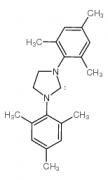1,3-Bis(2,4,6-Trimethylphenyl)-4,5-Dihydroimidazol-2-ylidene
- 中文别名:1,3 - 双(2,4,6 - 三甲基)-2-甲基-4,5 - 二氢咪唑
- 中文释义:1,3-双(2,4,6-三甲基苯基)-2-咪唑烷亚基;1,3-双(2,4,6-三甲基苯基)-4,5-二氢咪唑-2-亚基
- 英文别名:1,3-bis(2,4,6-trimethylphenyl)-4,5-dihydro-2H-imidazol-1-ium-2-ide;
C-2353;
1,3-bis-(2,4,6-trimethylphenyl)-imidazolin-2-ylidene;
1,3-bis(2,4,6-trimethylphenyl)-4,5-dihydroimidazol-2-ylidene;
D3897;
1,3-bis(2,4,6-trimethylphenyl)imidazolidin-2-ylidene;
1,3-bis(2,4,6-trimethylphenyl)-4,5-dihydroimidazolin-2-ylidene;
N,N'-bis(2,4,6-trimethylphenyl)-4,5-dihydroimidazol-2-ylidene;
SIMes;
1,3-Bis(2,4,6-trimethylphenyl)-2-imidazolidinylidene
- CAS No.:173035-11-5
- 分子式:
C21H26N2
- 分子量:306.45
- 精确分子量:306.21000
- PSA:6.48000
- InChI:The Key: LSMWOQFDLBIYPM-UHFFFAOYSA-N
- 分子结构式:

MSDS
Section 1: Product Identification
Chemical Name:1,3-Bis(2,4,6-trimethylphenyl)-4,5-dihydroimidazol-2-ylidene, min. 98%
CAS Registry Number:173035-11-5
Formula:C21H26N2
EINECS Number:none
Chemical Family:N-heterocyclic carbene
Synonym:none
Section 2: Composition and Information on Ingredients
IngredientCAS NumberPercentACGIH (TWA)OSHA (PEL)
Title compound173035-11-5100%no datano data
Section 3: Hazards Identification
Emergency Overview:Irritating to skin, eyes and respiratory tract.
Primary Routes of Exposure:Inhalation, skin, eyes
Eye Contact:Causes slight to mild irritation of the eyes.
Skin Contact:Causes irritation to the skin
Inhalation:Irritating to the nose, mucous membranes and respiratory tract.
Ingestion:No information available on the physiological effects of ingestion. May be harmful if swallowed.
Acute Health Affects:Irritating to skin, eyes and respiratory tract.
Chronic Health Affects:No information on long-term chronic effects.
NTP:No
IARC:No
OSHA:No
SECTION 4: First Aid Measures
Immediately flush the eyes with copious amounts of water for at least 10-15 minutes. A victim may need
Eye Exposure:
assistance in keeping their eye lids open. Get immediate medical attention.
Wash the affected area with water. Remove contaminated clothes if necessary. Seek medical assistance if
Skin Exposure:
irritation persists.
Remove the victim to fresh air. Closely monitor the victim for signs of respiratory problems, such as difficulty
Inhalation:
in breathing, coughing, wheezing, or pain. In such cases seek immediate medical assistance.
Seek medical attention immediately. Keep the victim calm. Give the victim water (only if conscious). Induce
Ingestion:
vomiting only if directed by medical personnel.
SECTION 5: Fire Fighting Measures
Flash Point:no data
Autoignition Temperature:no data
Explosion Limits:no data
Extinguishing Medium:carbon dioxide, dry powder or foam
If this product is involved in a fire, fire fighters should be equipped with a NIOSH approved positive pressure
Special Fire Fighting Procedures:
self-contained breathing apparatus and full protective clothing.
Hazardous Combustion andIf involved in a fire this material may emit irritating fumes.
Decomposion Products:
Unusual Fire or Explosion Hazards: Flammable solid.
SECTION 6: Accidental Release Measures
Eliminate all ignition sources. Small spills can be mixed with vermiculite, sodium carbonate or other suitable
Spill and Leak Procedures:
non-combustible adsorbent and swept up.
SECTION 7: Handling and Storage
Handling and Storage:Store in a tightly sealed container under an inert atmosphere of nitrogen or argon. Keep in a cool, dry place.
SECTION 8: Exposure Controls and Personal Protection
Eye Protection:Always wear approved safety glasses when handling a chemical substance in the laboratory.
Skin Protection:Wear protective clothing and gloves.
Ventilation:Handle the material in an efficient fume hood.
If ventilation is not available a respirator should be worn. The use of respirators requires a Respirator
Respirator:
Protection Program to be in compliance with 29 CFR 1910.134.
Ventilation:Handle the material in an efficient fume hood.
Additional Protection:No additional protection required.
SECTION 9: Physical and Chemical Properties
Color and Form:white to off-white powder
Molecular Weight:306.45
Melting Point:no data
Boiling Point:no data
Vapor Pressure:no data
Specific Gravity:no data
Odor:none
Solubility in Water:insoluble
SECTION 10: Stability and Reactivity
Stability:air sensitive, moisture sensitive
Hazardous Polymerization:no hazardous polymerization
Conditions to Avoid:exposure to air and moisture
Incompatibility:oxidizing agents
Decomposition Products:carbon monoxide, carbon dioxide, nitrogen oxides and organic fumes
SECTION 11: Toxicological Information
RTECS Data:No information available in the RTECS files.
Carcinogenic Effects:no data
Mutagenic Effects:no data
Tetratogenic Effects:no data
SECTION 12: Ecological Information
Ecological Information:No information available
SECTION 13: Disposal Considerations
Disposal:Dispose of according to local, state and federal regulations.
SECTION 14: Transportation
Shipping Name (CFR):Flammable solids, Organic, N.O.S.
Hazard Class (CFR):4.1
Additional Hazard Class (CFR):NA
Packaging Group (CFR):II
UN ID Number (CFR):UN# 1325
Shipping Name (IATA):Flammable solid, Organic, N.O.S.
Hazard Class (IATA):4.1
Additional Hazard Class (IATA):NA
Packaging Group (IATA):II
UN ID Number (IATA):UN# 1325
SECTION 15: Regulatory Information
TSCA:Not listed in the TSCA inventory
SARA (Title 313):Title compound not listed
Second Ingredient:none
SECTION 16 - ADDITIONAL INFORMATION
N/A
